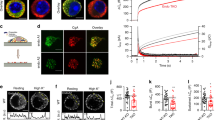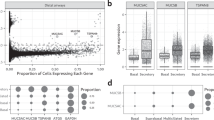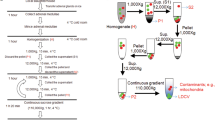Abstract
Chromaffin cells release catecholamine- and peptide-containing granules by exocytosis1–5, by a mechanism involving movement of secretory granules towards the cell membrane, their apposition to it and the fusion of the granule membrane with the plasma membrane. One of the two subunits of membrane-associated brain spectrin, α-fodrin is an actin-binding protein which is found at the periphery of chromaffin cells and may be involved in secretion6. Because cultured chromaffin cells can be permeabilized with detergents7–9, giving pores large enough to permit the entry of immunoglobulin molecules, we used permeabilized cells to test the effect of specific antibodies on secretory mechanisms. Incubation of permeabilized cells with polyclonal immunoaffinity-purified monospecific anti-α-fodrin antibody or its Fab fragments did not modify basal release but did specifically inhibit Ca2+-induced catecholamine release by exocytosis. Our observations indicate that fodrin and the cytoskeleton participate in the release mechanism.
This is a preview of subscription content, access via your institution
Access options
Subscribe to this journal
Receive 51 print issues and online access
$199.00 per year
only $3.90 per issue
Buy this article
- Purchase on Springer Link
- Instant access to full article PDF
Prices may be subject to local taxes which are calculated during checkout
Similar content being viewed by others
References
Diner, O. C. r. Hebd. Séanc. Acad. Sci. Paris 265, 616–619 (1967).
Douglas, W. W. Br. J. Pharmac. 34, 451–474 (1968).
Smith, A. D. & Winkler, H. in Handbk exp. Pharmac. 33, 538–617 (Springer, Berlin, 1972).
Viveros, O. H. Handbk Physiol. 6, 389–426 (1975).
Burgoyne, R. D. Bwchim. biophys. Acta 779, 201–216 (1984).
Perrin, D. & Aunis, D. Nature 315, 589–592 (1985).
Brooks, J. C. & Treml, S. J. Neurochem. 40, 468–473 (1983).
Wilson, S. P. & Kirshner, N. J. biol. Chem. 258, 4994–5000 (1983).
Dunn, L. A. & Holz, R. W. J. biol. Chem. 258, 4989–4993 (1983).
Knight, D. K. & Baker, P. F. J. Memb. Biol. 68, 107–140.
Bader, M. F., Thiersé, D., Aunis, D., Ahnert-Hilger, G. & Gratzl, M. J. biol. Chem. 261, 5777–5783 (1986).
Ehrhart, M., Grube, D., Bader, M. F., Aunis, D. & Gratzl, M. J. Histochem. Cytochem. 34, 1673–1682 (1986).
Hunter, A., Waldron, K. & Apps, D. K. FEBS Lett. 144, 51–56 (1982).
Winkler, J., Apps, D. K. & Fischer-Colbrie, R. Neuroscience 18, 261–290 (1986).
Abbs, M. T. & Phillips, J. H. Biochim. biophys. Acta 595, 200–221 (1980).
Geiger, B. Biochim. biophys. Acta 737, 305–341 (1983).
Geiger, B. Cell 18, 193–205 (1979).
Aunis, D. & Perrin, D. J. Neurochem. 42, 1558–1569.
Langley, O. K., Perrin, D. & Aunis, D. J. Histochem. Cytochem. 34, 517–525 (1986).
Cheek, T. R. & Burgoyne, R. D. FEBS Lett. 207, 110–114 (1986).
Porter, R. R. Biochem. J. 73, 119–126 (1959).
Bader, M. F. & Aunis, D. Neur science 8, 165–181 (1983).
Louvard, D., Vannier, C., Maroux, S., Pages, J. M. & Lazdunski, C. Analyt. Biochem. 76, 83–96 (1976).
Feramisco, J. R. & Burridge, K. J. biol. Chem. 255, 1154–1159 (1980).
Fenwick, C. M., Fajdiga, P. F., Howe, N. B. S. & Livett, B. G. J. Cell Biol. 76, 12–30 (1978).
Bader, M. F., Ciesielski-Treska, J., Thiersé, D., Hesketh, J. E. & Aunis, D. J. Neurochem. 37, 917–933 (1981).
Keningsberg, R. L. & Infaro, J. M. Neuroscience 5, 1547–1556 (1980).
Davis, J. & Bennett, V. J. biol. Chem. 258, 7757–7768 (1983).
Hinton, D. M., Perrali, J. P., Meyer, H.G. & Sternberger, L. A. J. Histochem. Cytochem. 21, 978–998 (1973).
Author information
Authors and Affiliations
Rights and permissions
About this article
Cite this article
Perrin, D., Langley, O. & Aunis, D. Anti-α-fodrin inhibits secretion from permeabilized chromaffin cells. Nature 326, 498–501 (1987). https://doi.org/10.1038/326498a0
Received:
Accepted:
Published:
Issue Date:
DOI: https://doi.org/10.1038/326498a0
This article is cited by
-
Sjögren’s Syndrome—Study of Autoantigens and Autoantibodies
Clinical Reviews in Allergy & Immunology (2007)
-
Temporal and spatial coordination of exocytosis and endocytosis
Nature Reviews Molecular Cell Biology (2003)
-
ATP-dependent inositide phosphorylation required for Ca2+-activated secretion
Nature (1995)
-
Lateral movement of mast cell surface protein detected by gold-labeled anti-IgE and its relation with fodrin
Agents and Actions (1994)
-
Membrane fusion
Experientia (1990)
Comments
By submitting a comment you agree to abide by our Terms and Community Guidelines. If you find something abusive or that does not comply with our terms or guidelines please flag it as inappropriate.



